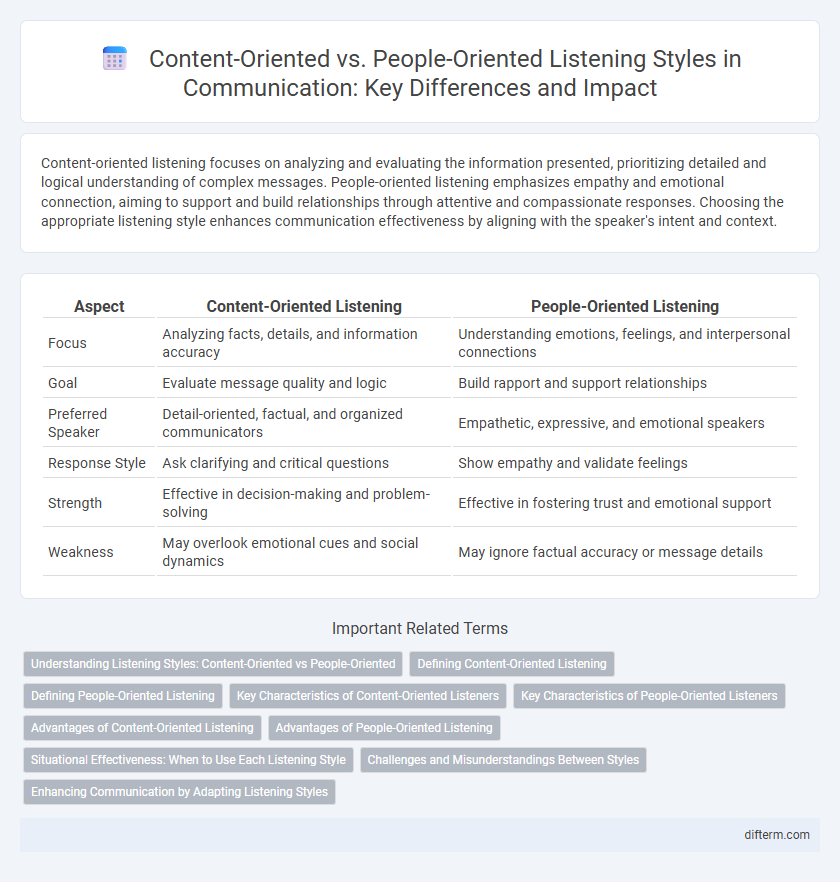Content-oriented listening focuses on analyzing and evaluating the information presented, prioritizing detailed and logical understanding of complex messages. People-oriented listening emphasizes empathy and emotional connection, aiming to support and build relationships through attentive and compassionate responses. Choosing the appropriate listening style enhances communication effectiveness by aligning with the speaker's intent and context.
Table of Comparison
| Aspect | Content-Oriented Listening | People-Oriented Listening |
|---|---|---|
| Focus | Analyzing facts, details, and information accuracy | Understanding emotions, feelings, and interpersonal connections |
| Goal | Evaluate message quality and logic | Build rapport and support relationships |
| Preferred Speaker | Detail-oriented, factual, and organized communicators | Empathetic, expressive, and emotional speakers |
| Response Style | Ask clarifying and critical questions | Show empathy and validate feelings |
| Strength | Effective in decision-making and problem-solving | Effective in fostering trust and emotional support |
| Weakness | May overlook emotional cues and social dynamics | May ignore factual accuracy or message details |
Understanding Listening Styles: Content-Oriented vs People-Oriented
Content-oriented listening focuses on evaluating and analyzing information for accuracy and logic, prioritizing message details and critical thinking. People-oriented listening emphasizes empathy and emotional connection, seeking to understand speakers' feelings and establish rapport. Recognizing these distinct listening styles enhances communication effectiveness by aligning responses with listener preferences.
Defining Content-Oriented Listening
Content-oriented listening emphasizes evaluating and analyzing the information presented, prioritizing the accuracy, logic, and depth of the message. Listeners with this style focus on understanding detailed facts and complex ideas to form a well-informed judgment. This approach is common in academic, professional, and technical communication environments where critical thinking is essential.
Defining People-Oriented Listening
People-oriented listening prioritizes understanding emotions and building connections by focusing on the speaker's feelings and perspectives. This listening style emphasizes empathy, fostering trust and rapport to create a supportive communication environment. Active engagement and validating the speaker's experiences are key elements distinguishing people-oriented listening from content-oriented approaches.
Key Characteristics of Content-Oriented Listeners
Content-oriented listeners engage deeply with messages by prioritizing detailed information, logical analysis, and evidence-based arguments. They seek clarity and tend to evaluate the accuracy and relevance of content before forming judgments, often asking probing questions. This listening style is common among professionals who require critical thinking and precision, such as researchers, analysts, and educators.
Key Characteristics of People-Oriented Listeners
People-oriented listeners prioritize empathy, showing genuine concern for the speaker's emotions and building interpersonal connections. They provide supportive feedback, encouraging open dialogue and trust through attentive and compassionate responses. This style enhances relationship satisfaction and promotes cooperative communication in both personal and professional contexts.
Advantages of Content-Oriented Listening
Content-oriented listening enhances critical thinking by encouraging careful evaluation of complex information and diverse viewpoints. This style improves problem-solving skills, enabling listeners to analyze and interpret data thoroughly. It fosters informed decision-making, making it essential in academic, professional, and technical communication contexts.
Advantages of People-Oriented Listening
People-oriented listening enhances empathy and emotional connection by prioritizing understanding others' feelings and perspectives. This style fosters trust and rapport, facilitating deeper interpersonal relationships and effective conflict resolution. Emphasizing people-oriented listening improves collaboration in team environments by making individuals feel valued and heard.
Situational Effectiveness: When to Use Each Listening Style
Content-oriented listening excels in situations demanding critical analysis and detailed understanding, such as technical meetings or complex problem-solving discussions. People-oriented listening is most effective during interpersonal exchanges requiring empathy and emotional support, like counseling sessions or conflict resolution. Choosing the appropriate listening style based on the situational context enhances communication effectiveness and relational outcomes.
Challenges and Misunderstandings Between Styles
Content-oriented listeners prioritize detailed information and critical evaluation, often leading to misunderstandings with people-oriented listeners who focus on emotional connection and empathy. Challenges arise when content-oriented listeners perceive people-oriented listeners as overly emotional or vague, while people-oriented listeners view content-oriented listeners as cold or dismissive. This disconnect hampers effective communication, highlighting the need to balance informational accuracy with empathetic engagement.
Enhancing Communication by Adapting Listening Styles
Adapting listening styles by balancing content-oriented and people-oriented approaches enhances communication effectiveness. Content-oriented listeners prioritize data accuracy, logical analysis, and detailed information, while people-oriented listeners emphasize empathy, emotional cues, and relational harmony. Tailoring listening behavior to the audience's needs fosters trust, minimizes misunderstandings, and promotes mutual understanding in interpersonal and professional dialogues.
content-oriented vs people-oriented (listening styles) Infographic

 difterm.com
difterm.com